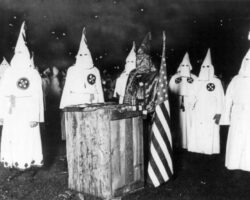Freedom of speech is one of America’s most crucial yet controversial rights. Activists often use the right of free speech to advocate for policies just as some people use the same right to make racist remarks. Until 1969, this law wasn't clarified.
In 1969, Clarence Brandenburg, a leader of the Ku Klux Klan in Ohio, gave a racist speech advocating for violence and accusing the government of suppressing whites. He was immediately charged under an Ohio law that prohibited people from advocating for violence and crime, fined $1000, and sentenced 1-10 years in prison. Brandenburg appealed this decision, claiming it was unconstitutional and that it violated his right to freedom of speech. The Supreme Court of Ohio dismissed his appeal, but the U.S. Supreme Court later found that Ohio did, in fact, violate his First Amendment right to freedom of speech.
 While reviewing the case, the court established a concept called imminent lawless action. It’s a standard currently used to test whether free speech is protected by the First Amendment. For example, free speech is not protected if someone has the intention of inciting violence that is imminent and likely. The Supreme Court also found that Brandenburg’s speech was merely an “abstract discussion,” making it very different from preparing a group of people to incite actual violence. Due to this case, we now have two standards used today to test whether speech is legal.
While reviewing the case, the court established a concept called imminent lawless action. It’s a standard currently used to test whether free speech is protected by the First Amendment. For example, free speech is not protected if someone has the intention of inciting violence that is imminent and likely. The Supreme Court also found that Brandenburg’s speech was merely an “abstract discussion,” making it very different from preparing a group of people to incite actual violence. Due to this case, we now have two standards used today to test whether speech is legal.If the following two conditions are met, the speech is illegal.
1. The purpose of the speech is to incite illegal actions, such as violence.
2. This action is likely to take place. Still, this is a controversial issue today, as hate speech is becoming more prevalent. Under lawless imminent domain, hate speech is perfectly legal as long as it does not provoke violence.
Sources:
https://www.oyez.org/cases/1968/492
https://globalfreedomofexpression.columbia.edu/cases/brandenburg-v-ohio/

What an interesting blog post! Truly, the limitations of free speech has always been something that intrigued me. Supreme Court has struggled with defining free speech, but each new case provides a new angle to approach it. For example, in Tinker v. Des Moines, the Supreme Court extended free speech to allow students to protest the war, saying that, “Students do not shed their constitutional rights at the schoolhouse gate.” Another aspect of free speech that is often overlooked is the right to not speak. This aspect was also applied in the right to refrain from saluting the flag based off of the West Virginia Board of Education v. Barnette decision, where Jehovah's Witness students were kicked out of school for refusing to salute the flag.
ReplyDeletePersonally, I feel that free speech is a fantastic idea in theory, especially for a country that promotes freedom and democracy. However, the reality is that true free speech would endanger the fragile harmony of society. Restrictions on free speech raise the question, "Which is more important, individuality and expression or security and cohesiveness?"
Sources:
https://www.oyez.org/cases/1940-1955/319us624
https://www.uscourts.gov/about-federal-courts/educational-resources/about-educational-outreach/activity-resources/what-does
I really enjoyed how this article provided more insight into the terms of freedom of speech and what exactly it entails. I couldn't help to think about the issue of freedom of speech on college campuses. It is a controversial issue of who is "allowed" to speak at college campuses. Conservative voices have been met with opposition. However, despite ones political opinion, at a public university, if a speaker isn't inciting violence or hate, as underlined in this post, they have the right to speak.
ReplyDeleteSource:
https://www.aclu.org/other/speech-campus
Wow this is a very interesting blog post because it points out the "flaws' and loopholes in the first amendment's wording. It is very hard to distinguish what qualifies as "inciting violence". Additionally, all of this falls under a matter of perspective. How is one supposed to determine whether the event is likely to occur without bias? It's impossible. So you are right some people will continue to abuse their right to free speech even when they are aware of the implications.
ReplyDelete